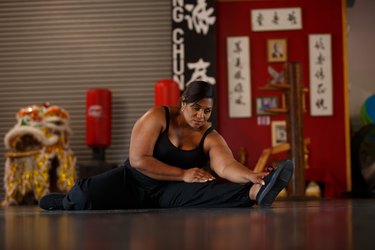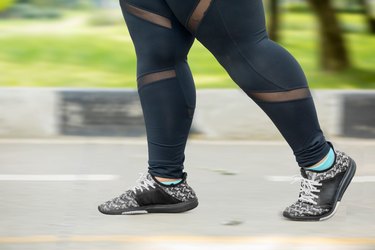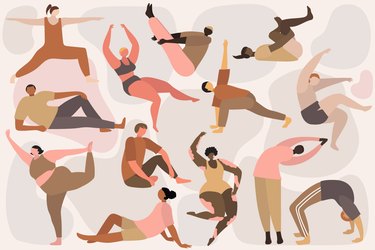
I've worked as a fitness coach for eight years. During that time, I've coached many clients with obesity. Everyone comes to me in a different place. Some clients with obesity are strong, exercise regularly and have minimal (if any) joint pain. Others are much more limited in their physical ability and may be dealing with multiple sources of chronic pain.
One thing I've noticed is that many people who have obesity worry about the long-term health of their joints. Although there is a correlation between obesity and eventually developing joint pain or disease, there are steps you can take to reduce your risk or delay the onset of problems.
Video of the Day
Video of the Day
I've seen plenty of anecdotal evidence that strength training can reduce the severity of existing joint pain and potentially delay the onset of new pain in my clients.
I also know from personal experience that weight loss combined with strength training can help with joint pain. Back in 2011, I had obesity and knee and lower back pain. Daily life tasks like climbing stairs and sitting for long periods of time were challenging for me. I rode my bike and walked around my college campus but was otherwise inactive.
That year, I began an extended effort to lose weight. I started lifting weights and taking cardio classes at my campus gym. Slowly, as I got stronger and lighter, my pain began to subside. I no longer struggled to climb stairs or sit without back pain during long lectures. Eventually, once I had lost around 15 percent of my body weight, my pain went away completely.
While losing weight will certainly relieve pressure on your joints, people with obesity can also benefit greatly from focusing on exercises that build strength in the lower body and core. Targeting these areas will give your knees, hips, ankles and lower back some extra support, protecting them over time. The best specific exercises for you will vary based on your past training experience and history of pain (or lack thereof).
What the Science Says About Obesity and Joint Pain
A significant amount of research links obesity — which the Centers for Disease Control and Prevention (CDC) defines as having a body mass index (BMI) of 30 or higher — with joint pain and diseases, particularly osteoarthritis.
For instance, a December 2015 review in BMJ Open found obesity was a key risk factor for developing osteoarthritis in the knee. Osteoarthritis (OA) is the most common form of arthritis — which just means a group of diseases that cause joint swelling and inflammation. According to the Arthritis Foundation, OA is more severe and progresses faster in people with obesity, and those with BMIs in the overweight or obesity categories are more likely to need a hip or knee replacement.
However, it's important to note that having obesity does not guarantee you will end up with joint pain or OA. Likewise, not having obesity does not mean you will never have to deal with joint pain or OA. All bodies are subject to the natural effects of aging, which causes bones and surrounding soft tissues — including the connective tissue in the joints, called cartilage — to wear down and weaken over time, says physical therapist Kevin Linde, LPT. This means as people get older, they can expect to deal with at least some joint pain.
Past sports injuries, inflammation, genetic predisposition and simply getting older all increase your risk of developing OA and other joint diseases.
But carrying around extra weight does put increased strain on the joints over time, which can increase the risk of OA, says Vaishali Geib, MD, an internal medicine physician in Winchester, Virginia. The lower extremity joints — the hips, knees and ankles — as well as the lower back are particularly at risk because they are responsible for carrying much of our weight as we move, Dr. Geib adds.
There's also evidence that excess fat in the body increases systemic inflammation, which further contributes to stiff, achy joints, according to the Arthritis Foundation. This increased inflammation can also make the joints more likely to degrade and develop OA.
Losing even 5 to 10 percent of your body weight can help a lot with joint pain, according to Dr. Geib. You also might be able to delay joint problems by strengthening your muscles, bones and joints through some good old-fashioned resistance training.
How Exercise Can Decrease Joint Pain
Exercise — particularly resistance training — is a proven tool to reduce the severity of joint pain and delay the onset of future problems.
Resistance training can help reduce knee pain from osteoarthritis, make daily activities easier and improve quality of life, according to a May 2012 article in PM&R: The Journal of Injury, Function and Rehabilitation. And an older September 2008 meta-analysis in Arthritis Care and Research found resistance training can reduce pain and improve physical function in people with OA. Increased quad strength was especially important to counteract the effects of knee OA.
In general, strong muscles support whatever joints they're connected to, taking away some of the stress and pressure. For example, your quads are a major support system for your knees. When you jump, squat, run or do any other lower-body movement, your quads fire up and handle a lot of the work so that your knee joints don't have to.
Exercise also promotes the flow of fluid in the joints. This fluid carries nutrients that keep the cartilage (and the whole joint) healthy, Linde says. The cartilage itself doesn't have a blood supply, so it needs this fluid to get oxygen and other nutrients. When you load a joint, fluid filled with waste products squeezes out; when you relieve the pressure, nutrient-rich fluid seeps back in, according to the University of Washington.
However, it's crucial to find the right balance: If your knee is achy and already damaged, too much or the wrong type of impact can make things worse. You want just enough stress on the area to build the surrounding muscles and keep the joint moving in a healthy way.
4 Strength-Training Tips to Improve Joint Health With Obesity
If you want to use strength training to bolster your joints, here are four things you should focus on. Consider consulting with a trainer or physical therapist who has experience working with people with obesity.
1. Focus on Building Lower-Body Strength
Lower-body joints — hips, knees, ankles, lower back — are most at risk for pain if you have obesity. Resistance training strengthens the supporting muscles around these vulnerable joints, providing greater stability, Linde says.
In particular, building strong quads, hamstrings, glutes and calves can help your ankles, knees and hips move better and absorb more force.
Strengthening the muscles around one joint can also help a seemingly unrelated joint. Everything is connected, after all. For example, strengthening the muscles of the hip can improve pain at the knee, Kyle Feldman, DPT, physical therapy director at ReShape, tells LIVESTRONG.com. "If your hips don't move well, your knees are highly affected," he says. "The whole extremity is a chain, and for best results we need to look at how things work together."
Lower-body exercises that help build strength and promote healthy joints include:
2. Don't Forget About Your Core
Core strength is also crucial. The core helps support your every movement, and most importantly, protects your lower back.
Oftentimes, people with abdominal obesity compensate by arching — and straining — their lower back, Dr. Geib says. My coaching experience has shown me that clients with more core strength and stability are better able to reduce low back pain.
Linde says patients with obesity often struggle with transitional movements, like getting up and down or rolling over in bed, due to disconnection and weakness in their core. One example of how he targets this is by teaching people how to use their lower-body muscles and the core to properly stand up from a chair: Hinge at the hips, engage the deep core muscles and use the legs to push and stand up without using the arms.
If you are able to get up and down from the floor, try these exercises to build more deep core strength:
If getting up and down from the floor is too challenging, you can still build a stronger core using these standing exercises:
- Anti-rotation (Pallof) press
- Farmer's walk and single-arm farmer's walk
- Chop and lift
- Modified planks with hands on a box or chair
3. Modify Your Workout to Meet Your Fitness Level
No matter your weight, it's important to always consider any medical conditions, current fitness level and exercise experience before doing a single squat.
If you have obesity, but don't have any current pain: I suggest following a full-body strength-training program using exercises like squats and hip hinges, upper-body pushing and pulling exercises and core exercises. If your knees can tolerate it, building single-leg strength and stability using split squats, step-ups and lunges can be helpful, too.
Always prioritize good form — preferably under the guidance of a trainer or coach — before adding any free weights (like dumbbells or kettlebells). Once you feel comfortable with your program, focus on getting stronger by gradually adding load or difficulty.
If existing joint pain is affecting your workouts: Modifications may help you train around the pain. Ideally, you'd work with an experienced trainer who can help you identify effective and safe modifications for you.
Here are some modifications I've used in my coaching practice:
- Use split squats instead of lunges.
- Use single-leg glute bridge variations instead of lunges, split squats or step-ups.
- Focus on building leg strength through posterior chain exercises like Romanian deadlifts and leg curls if knee-dominant exercises (like squats and lunges) are painful.
- Avoid jumping exercises.
- If getting down to the floor or lying on a bench is impractical, use seated and standing exercises instead.
- Use machines if you need more support or if you want to be able to increase weight in small increments.
If you have obesity and intense joint pain or movement limitations: Aquatic exercise can be a great solution. When you work out in the water, the impact on your joints is much lower and you can move more freely. In fact, Linde, Feldman and Dr. Geib all recommend water-based resistance training programs for their patients with obesity. You can start by practicing walking with high knees and moving your hips in different planes of motion.
4. Create Psychological Safety
Knowing the benefits of exercise is only part of the battle for some with existing pain. People with OA or other joint problems may find themselves trapped in a vicious cycle where they need to exercise more to improve their health, but are afraid to do so because it hurts. Additionally, mental health challenges associated with both OA and obesity can make it even more challenging to get moving.
It's crucial to find forms of exercise that feel safe — but whether that's pool-based workouts, lifting on the gym floor or something else entirely is up to you. This is another reason why working with a trainer who can show you the ropes and give you form feedback can be invaluable. Building confidence in your body and the movements you're doing can help you feel comfortable and stay motivated.
Finally, if you have obesity and joint pain, consider seeking additional care if you are able to do so. There may be other factors affecting your joints, and addressing them all will help you move with less pain for longer.
- Rheumatology: "Obesity and osteoarthritis, more than just wear and tear: pivotal roles for inflamed adipose tissue and dyslipidaemia in obesity-induced osteoarthritis"
- Pain Research and Management: "Obesity and Multisite Pain in the Lower Limbs: Data from the Osteoarthritis Initiative"
- Clinical and Experimental Rheumatology: "Osteoarthritis is a serious disease"
- PM&R: The Journal of Injury, Function and Rehabilitation: "Resistance Exercise for Knee Osteoarthritis"
- Arthritis and Rheumatism: "Strength training for treatment of osteoarthritis of the knee: A systematic review"
- Obesity: "Obesity and Pain Are Associated in the United States"
- Cochrane Library: "Aquatic exercise for the treatment of knee and hip osteoarthritis"
- Cochrane Library: "Exercise interventions and patient beliefs for people with hip, knee or hip and knee osteoarthritis: a mixed methods review"
- BMJ Open: "Body mass index and risk of knee osteoarthritis: systematic review and meta-analysis of prospective studies"
- Arthritis Foundation: "How Fat Affects Osteoarthritis"
- University of Washington: "Joints"


